Looking for a Vehicle Valuation or HPI Check?

This is the editorial commentary to accompany the cap hpi guide to future residual values for used cars.
The content is as follows:
- gold book forecast accuracy
- Forecast changes this month
- Market overview
- gold book methodology
- Reforecast calendar 2018-2019
1. gold book Forecast Accuracy
As gold book matures since its introduction in December 2013, we have the data to enable us to measure our results in terms of forecast accuracy. The accuracy target widely demanded by our customers is to be within 5% of actual values and we are pleased that, averaged across all models, gold book has been generally within this target since launch.
The unexpected growth in strength of petrol car values through 2017 and into 2018, as a result of anti-diesel press, has resulted in our recent accuracy results showing a more under-forecast than was previously the case, especially in the City Car and Supermini sectors. We expect this position to correct over time due the sector reforecasts made in 2017, and our expectation that petrol strength will start to diminish as petrol values peak and more used petrol volume comes the market.
The results of our longer-term forecasts from 3 and 4 years ago have so far shown more under-forecast than the results of our shorter-term forecasts from 1 and 2 years ago. This is largely because the impact of changes made in previous sector reforecasts take longer to flow through into our accuracy results.
Used car accuracy reporting remains unweighted, unlike new car accuracy reporting which has been weighted by registration volume since April 2018. It is our intention to make the switch to weighting for used cars in the future.
This month we are able to include a breakdown of accuracy by fuel type, for 3 and 4 year forecasts, for the first time.
Also, this month we have re-introduced tables showing the current months’ accuracy figures, following feedback that some customers use these tables for their own tracking purposes.
12 month results
Since measurement started our 12 month used forecasts have averaged -0.2% less than black book across all vehicle ids, and the most recent results show July 2017 12/20 gold book forecasts being -4.8% less than July 2018 12/20 black book.

Split by the main vehicle sectors, most of these have been within target for the majority of the reporting period, except for City Car and Supermini which were initially over-forecast as a result of unforeseen and prolonged excessive forced registrations, and more recently some sectors, notably City Car, have been under-forecast due to the unexpected strength of petrol values since 2017
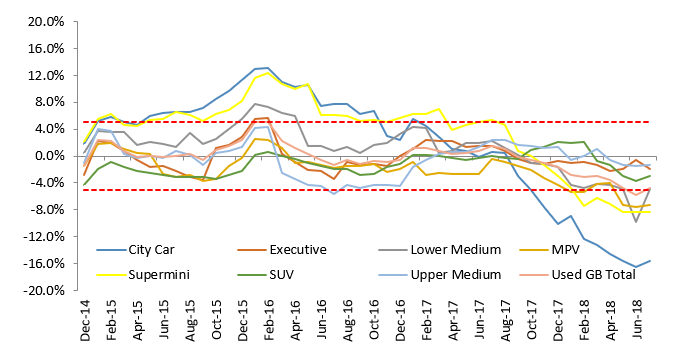
The most recent results for these main sectors are as follows:
|
Row Labels |
Average of GB Diff (%) |
|
City Car |
-15.6% |
|
Executive |
-1.9% |
|
Lower Medium |
-4.9% |
|
MPV |
-7.3% |
|
Supermini |
-8.4% |
|
SUV |
-2.9% |
|
Upper Medium |
-1.4% |
|
Grand Total |
-4.8% |
24 month results
Since measurement started our 24 month used forecasts have averaged -1.6% less than black book across all vehicle ids, and the most recent results show July 2016 24/40 gold book forecasts being -5.9% less than July 2018 24/40 black book.
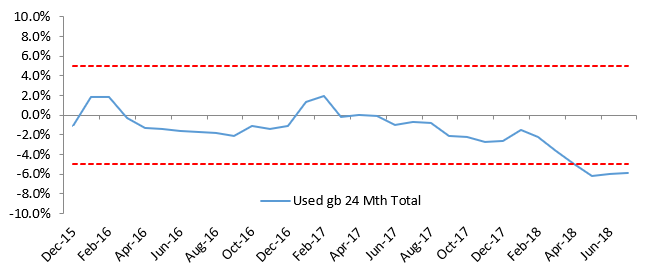
Split by the main vehicle sectors, most of these have been within target for the majority of the reporting period, except for City Car and Supermini which were initially over-forecast as a result of unforeseen and prolonged excessive forced registrations, and more recently some sectors, notably City Car, have been under-forecast due to the unexpected strength of petrol values since 2017
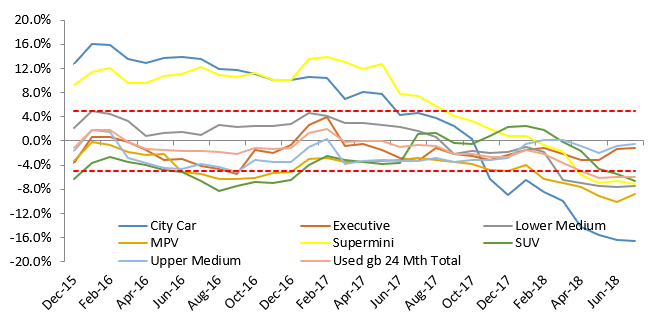
The most recent results for these main sectors are as follows:
|
Row Labels |
Average of GB Diff (%) |
|
City Car |
-16.6% |
|
Executive |
-1.2% |
|
Lower Medium |
-7.5% |
|
MPV |
-8.7% |
|
Supermini |
-7.1% |
|
SUV |
-6.6% |
|
Upper Medium |
-0.6% |
|
Grand Total |
-5.9% |
36 month results
Since measurement started our 36 month used forecasts have averaged -2.3% less than black book across all vehicle ids, and the most recent results show July 2015 36/60 gold book forecasts being -8.1% less than July 2018 36/60 black book.
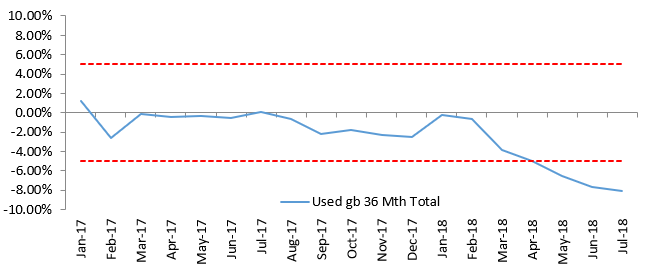
Split by fuel type, diesel accuracy remains within target while petrol accuracy has been adversely affected by the current market strength for petrol.

Split by the main vehicle sectors, most of these have been within target for the majority of the reporting period, except for City Car and Supermini which were initially over-forecast as a result of unforeseen and prolonged excessive forced registrations. Their accuracy has continued to improve as the impact of historic sector reforecasts flow through into the results. More recently most sectors have been under-forecast due to the unexpected strength of petrol values since 2017.
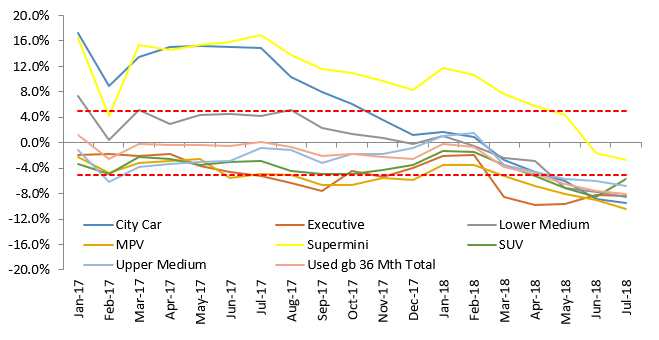
The most recent results for these main sectors are as follows:
|
Row Labels |
Average of GB Diff (%) |
|
City Car |
-9.5% |
|
Executive |
-8.4% |
|
Lower Medium |
-8.6% |
|
MPV |
-10.4% |
|
Supermini |
-2.7% |
|
SUV |
-5.7% |
|
Upper Medium |
-6.8% |
|
Grand Total |
-8.1% |
48 month results
Since measurement started our 48 month used forecasts have averaged -3.4% less than black book across all vehicle ids, and the most recent results show July 2014 48/80 gold book forecasts being -6.2% less than July 2018 48/80 black book.
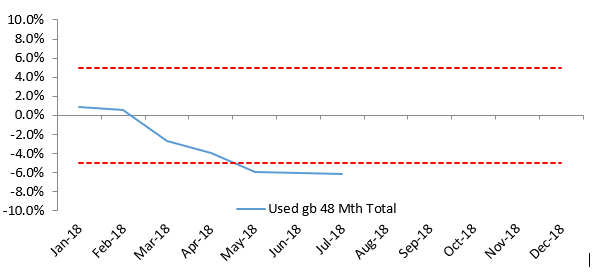
Split by fuel type, diesel accuracy remains within target while petrol accuracy has been adversely affected by the current market strength for petrol.
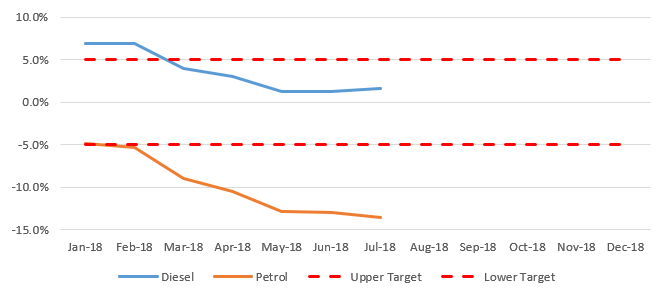
Split by the main vehicle sectors, City Car and Supermini were initially over-forecast as a result of unforeseen and prolonged excessive forced registrations. Their accuracy will continue to improve as the impact of historic sector reforecasts flow through into the results. More recently other sectors have been under-forecast due to the unexpected strength of petrol values since 2017.
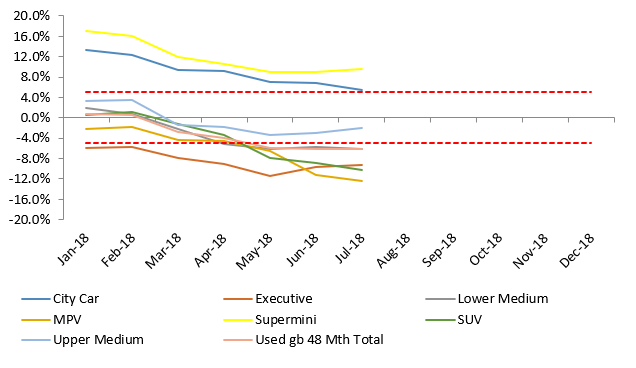
The most recent results for these main sectors are as follows:
|
Row Labels |
Average of GB Diff (%) |
|
City Car |
5.4% |
|
Executive |
-9.3% |
|
Lower Medium |
-6.1% |
|
MPV |
-12.4% |
|
Supermini |
9.7% |
|
SUV |
-10.3% |
|
Upper Medium |
-2.0% |
|
Grand Total |
-6.2% |
Overall results
We are pleased with these accuracy results since the launch of gold book, despite the recent fall-off in accuracy due to current market conditions, which we do not expect to last. We are taking advantage of our new methodology to implement a ‘virtuous feedback loop’, with each element of the forecast examined to determine how best to further improve the accuracy of our future value forecasts, while also reducing variation. This has shown itself to be effective over the relatively long period we have been measuring 12 and 24 month results, and we expect the same to be true of our future 36 and 48 month results.
We will continue to publish these results and share them with our customers.
2. Forecast changes this month:
This month, we publish our new reforecasts for the MPV, Convertible, and Coupe Cabriolet sectors.
We have reviewed and revised our future market deflation assumptions for these sectors, based on our latest forecasts for new car registration volumes, and the latest UK economic forecasts. These determine the balance of used car supply and demand, which drives future market deflation/inflation.
In the MPV sector we consider that over the next five years, overall registration volumes will continue to decline with customers moving primarily into similar size SUVS, and manufacturers replacing MPVs with SUVs. There will continue to be an overall shift from diesel into petrol, especially for the smaller MPVs. Used supply will reduce in future years, but we expect used demand will remain quite strong especially those models with 7 seats. The balance of supply and demand will tip in favour of less deflation, especially for petrol models.
In the Convertible sector we consider that over the next five years, overall registration volumes will continue to decline and there will continue to be a shift from diesel into petrol. Future used demand will continue to broadly balance the change in used supply for both fuel types; with the scales tipping in favour of less deflation for petrol models.
The Coupe Cabriolet sector now comprises of only three model ranges, and we consider it appropriate to now use the same deflation assumptions as the Convertible sector.
The impact of the revised deflation assumptions on our 3 year used forecasts is set out below:
|
SECTOR |
DEFLATION CHANGE |
|
MPV Petrol MPV Diesel Convertible Petrol Convertible Diesel Coupe Cabriolet Petrol Coupe Cabriolet Diesel |
+3.0% +1.6% +3.2% +0.0% +3.3% -1.2% |
3. Market Overview
Brexit negotiations are ongoing, but the final outcome will still not start to become clear for some time. However, future trade agreements which negatively impact the UK economy (and that of other major EU states) are still considered unlikely.
The outlook for the UK economy remains unchanged. The latest new independent economic forecasts published by HM Treasury in May still do not forecast a recession and therefore remain in line with our own view, with a slight reduction in GDP in 2018 but recovering thereafter.
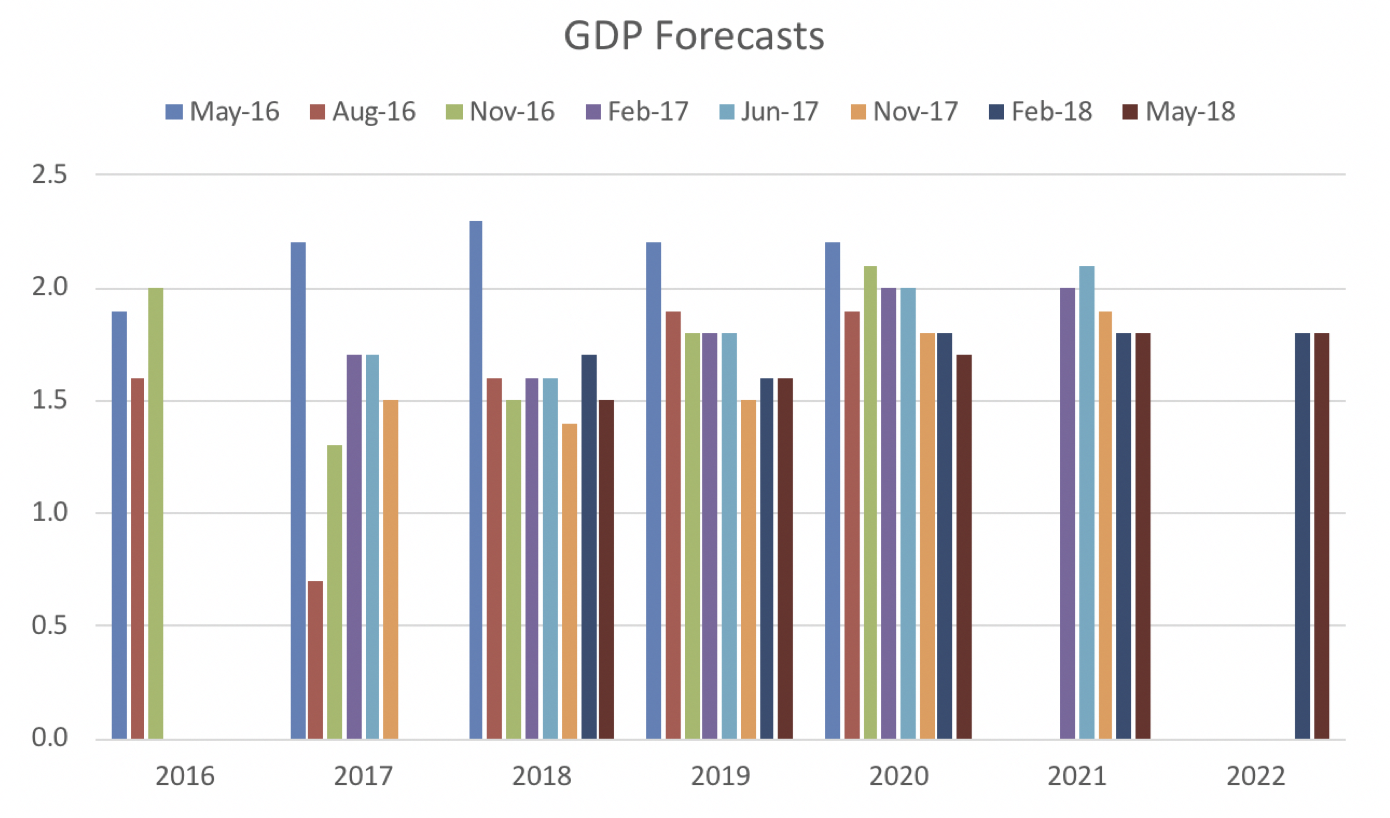
Not all ages and sectors of vehicle are directly impacted by GDP, and in some cases this will be offset by lower future registration volumes. Forecasts for inflation and unemployment show no obvious signs for concern.
We expect some mildly negative effects on the economy in the short to medium term, due to reduced business capital expenditure and investment, but expect consumer spending to continue to drive a stable economy. The protracted nature of the Brexit will allow time to assess the most likely outcome and future forecasts published by HM Treasury, therefore at present we are planning to conform to our original timetable of sector reforecasts and do not consider it necessary to embark on wholesale reforecasts.
As leasing and PCP returns increase, values are broadly expected to decrease in line with previous seasonal aging patterns, with negative impact from a slowing economy mitigated by the effects of decreased supply of nearly new cars.
In 2017, as we expected, the exchange rate level since the Brexit referendum made the UK less profitable for manufacturers and registration volumes fell by 5.7%, assisted by diversion of volume to other European countries, where pent up demand for new cars remains from the recession in 2008/2009.
In 2017, diesel registration volumes fell by 17.1%, accelerating the trend seen in recent years. In April 2018 we saw the implementation of an additional 1% BIK surcharge for diesel company cars that do not meet the latest emission standards; and an increase in the 1st year VED rate for diesel cars not meeting the latest emissions standards. Both of these changes are likely to further discourage new diesel registrations, which are down 30.6% ytd in 2018 (up to the end of May)
However diesel values have held up well (in line with our future deflation assumptions), but petrol and hybrid values have been particularly strong as buyers seek an alternative to diesel where available. We consider this current strength is not sustainable beyond the short term and values will start to fall back as they start to look too expensive and use supply of these fuel types starts to increase.

As 2018 progresses we expect the trends seen in 2017 to continue: a further fall in overall registration volumes, with diesel taking the largest fall (assisted by company car drivers avoiding the BIK taxation increase); with continuing stability in used diesel values, but with a softening of used petrol and hybrid values.
Demand Outlook
The outlook for the UK economy is uncertain in the context of Brexit but the consensus of the latest independent forecasts for GDP is no cause for alarm. Making decisions on interest rate changes based on % unemployment is far less reliable than it has been in the past and we are continuing to investigate whether we can usefully integrate any additional labour market metrics into our regression modelling (currently % unemployment is one of 15 labour market metrics studied). The unemployment rate remains low at 4.2%, and wage growth remains relatively slow by historic standards, especially given current labour market conditions.
Despite the base rate interest rate rise in November 2017 to 0.5%, and the possibility of a further increase, interest rates are expected to still remain low for the medium term. Any significant further increase in base rate still seem unlikely until there is a combination of further improvements in wage growth and increases in rates of headline inflation.
CPI has recently fallen back a little and is now at +2.4%, which still exceeds the Bank of England’s lower limit of +2%. RPI is at 3.4%.
Oil prices remain very hard to predict. During October 2016, the OPEC countries agreed to an initial cut production, which was then extended for a further 9 months and helped to ensure market stability. Now that supply is returning to levels commensurate with demand, oil prices are likely to rise steadily over the forecast period, but fuel prices will remain well below historic levels unless there are significant currency movements against the US Dollar.
Wage growth remains reasonably healthy, although slow by historical standards; and price inflation is now increasing; so these conditions should continue to provide a positive impetus to the overall economy.
Initial GDP results for Q4 2017 are +0.4%, indicating annual GDP for the whole of 2017 of around +1.7% (compared to 2.0% in 2016). Independent forecasts continue to indicate relatively stable growth rates throughout the next five years, with no organisation now predicting a recession within that period.
Consumer and Business Confidence had continued to increase slowly as we had expected, although post the Brexit referendum we now expect to see a decline in overall business investment, reversing the medium term trend, particularly in the large corporate sector. Much of the previous export growth was driven by the service sector, but this has slowed in recent months and there have also been increases in manufacturing and domestic car output. Much of this activity reflected the shift in export focus from the Eurozone to emerging economies and this is likely to continue, despite fluctuating Eurozone demand (see below), although exports still remain below the long term average. The UK will remain within the European Economic Area for the foreseeable future and despite previous statements from the EU and the UK government, it is difficult to envisage a realistic scenario whereby motor vehicles would not be part of a tariff free arrangement in the future.
Forecasts for future house price increases vary dramatically by sector and especially by geography. Despite a view expressed by the Bank of England’s Financial Stability Committee that the buy to let sector could “amplify” any boom or bust in the housing market, any negative effects are likely to be centred on London, with the rest of the country significantly more insulated from the impact of any such downturn.
Supply Outlook
Exchange rates are a major influence on the profitability of the UK new car market and they strongly influence eventual used vehicle volumes. Sterling rates against the Euro reduced as expected from around 1.43 in November 2015, to averaging 1.26 in April 2016 – equivalent to a -12% decrease in Euro revenue for the same vehicle sale - then fell further after the Brexit referendum to around 1.16 in early 2017 and settled at around 1.13 during the latter part of 2017, where they remain.
As a result, new car registrations for 2017 came in at 2.54M compared with 2016’s 2.69 million, with most of that fall coming from diesel registrations (down -17.1% year on year). We expect a further fall in registration volumes, especially for diesel, in 2018. Our view is that total volumes will fall by around -3% to -4% compared to 2017, and this will result in a reduction in used car supply in future years and will help to support used values.
The UK economic situation looks likely to continue to offset any remaining weakness in the Eurozone and Sterling is set to remain at a level that should limit manufacturers’ scope for heavy discounting and forced registration activity.
New car registrations in other key European market continue to grow as a result of the release of pent up demand. In the three years before the financial crisis, France, Germany, Italy and Spain represented an annual combined volume of almost 9.4 million units, and have recovered to 7.7 million in 2015, then 8.3M in 2016, and then 8.7M in 2017, suggesting there is still further growth to come.
4. Gold Book Methodology:
Overview
All of our future residual values are based on the gold book methodology. Our values take current month black book values as a starting point (uplifted for model changes where necessary), are moved forward according to age/sector/fuel specific year on year deflation assumptions regarding future used car price movements, and are then subjected to additional adjustments by the Editorial Team. Finally the values are moved forward by the next month’s seasonality adjustments which are differentiated by sector and fuel type and are based on analysis of historical black book movements.
All of these assumptions and adjustments are available for scrutiny to our customers through our gold book iQ product. For years our customers have been asking for transparency in automotive forecasting and we have delivered a ground-breaking product to provide exactly that.
With an increasing number of customers subscribing to gold book iQ, we are entering into a range of debates and discussions around both our overall forecasting methodology and individual elements of the forecasts for particular vehicles. This is expected to evolve over time into a ‘virtuous circle’, with the feedback looping back into the forecast process and delivering continuous improvement. We are embracing a new era of customer communication, with a greatly improved quality of interaction and debate around our forecast values.
A cycle of changes to our seasonality assumptions was completed in summer 2016 and these assumptions will be reviewed again within approximately 12 months’ time.
Changes may be actioned wherever there is reason to do so outside of the sector reforecast process and we continue our monthly Interproduct analysis with our black book colleagues exactly as before. This has intensified following the availability of our short term forecast data (gold book 0-12, now available to customers), which incorporates detailed exception reporting at a cap hpi ID level and will also be used increasingly going forward to manage the relationships between black book and gold book.
Our used gold book methodology was designed to feature 5 mileage bandings (rather than the 3 bandings which have traditionally been published) and the mileages tabulated in our database are now much more relevant to the age of the individual vehicle and are differentiated by sector and fuel type. Our used forecasts are also now available out for 5 years into the future for all vehicles currently up to 5 years old today. Our Windows, ASCII and SQL products remain technically the same, with the only changes being the methodology behind the forecast data and the selected mileages which are tabulated.
Forecasting Model Development – gold book & iQ
gold book iQ was launched in December 2013 and gives unparalleled transparent insight into the assumptions used to produce our forecasts.
Our short term forecast product, gold book 0-12, (also marketed as black book +12) was launched shortly afterwards. This is a live, researched product with a dedicated editor and fills a gap in our previous forecast coverage.
Following feedback on our gold book iQ product, from September 2016 we have added more detail into the commentary for each model range reforecast in sector reviews.
In December 2017 we introduced a daily feed of forecasts for new models launched onto the market, so that customers do not have to wait until the next month to receive these forecasts.
Forecast Output
Individual forecasts are provided in pounds and percentage of list price for periods of twelve to sixty months with mileage calculations up to 200,000.
Each forecast is shown in grid format with specific time and mileage bands highlighted for ease of use.
All forecast values include VAT and relate to a cap hpi clean condition and in a desirable colour.
Parallel Imports
Particular care must be taken when valuing parallel imports. Vehicles are often described as full UK specification when the reality is somewhat different. These vehicles should be inspected to ensure that the vehicle specification is correct for the UK. Parallel imports that are full UK specification and first registered in the UK can be valued the same as a UK-sourced vehicle.
Grey Imports
cap hpi gold book does not include valuations for any grey import vehicles, (i.e. those not available on an official UK price list).
New Prices
All new car prices in gold book include VAT and delivery.
5. Reforecast Calendar 2018/2019:
Monthly Product
Sector 1
Sector 2
Sector 3
Sector 4
Sep 18
Oct-18
Nov-18
Dec-18
Jan-19
Feb-19
Mar-19
Apr-19
May-19
June-19
Jul-18
Aug-18
Lower Medium
City Car
SUV
Upper Medium
MPV
Lower Medium
City Car
SUV
Upper Medium
MPV
Lower Medium
City Car
Sports
SuperMini
Electric
Executive
Convertible
Sports
Supermini
Electric
Executive
Convertible
Sports
Supermini
Supercar
Large Executive
Coupe Cabriolet
Supercar
Large Executive
Coupe Cabriolet
Supercar
Luxury Executive
Luxury Executive

UK Senior Editor Forecast Car Values
+44 (0) 113 222 2067
andrew.mee@cap-hpi.com
